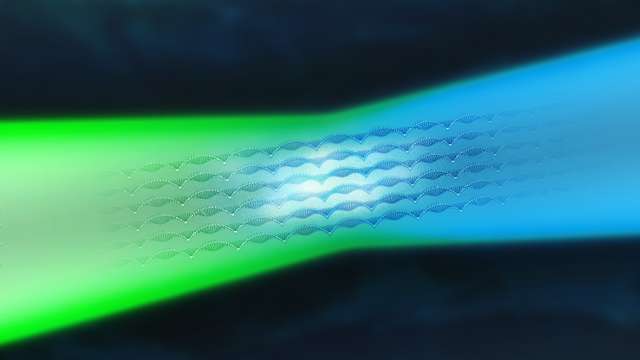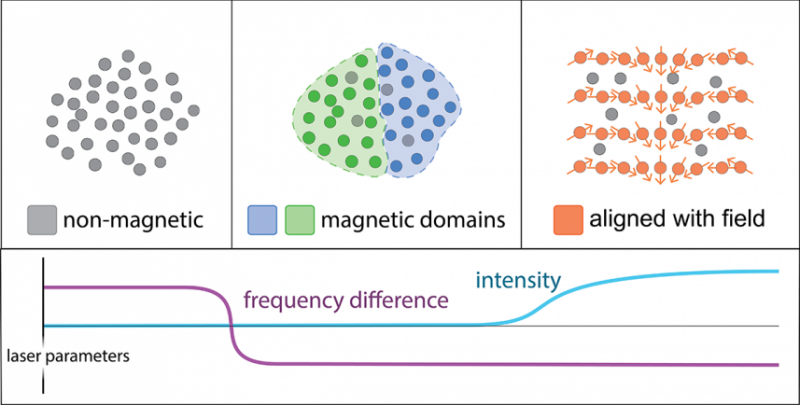Interfering lasers create an effective magnetic for a cloud of cold rubidium atoms. Credit: S. Kelley/JQI
The swirling field of a magnet—rendered visible by a sprinkling of iron filings—emerges from the microscopic behavior of atoms and their electrons. In permanent magnets, neighboring atoms align and lock into place to create inseparable north and south poles. For other materials, magnetism can be induced by a field strong enough to coax atoms into alignment.
In both cases, atoms are typically arranged in the rigid structure of a solid, glued into a grid and prevented from moving. But the team of JQI Fellow Ian Spielman has been studying the magnetic properties of systems whose tiny constituents are free to roam around—a phenomenon called "itinerant magnetism."
"When we think of magnets, we usually think of some lattice," says graduate student Ana Valdés-Curiel. Now, in a new experiment, Valdés-Curiel and her colleagues have seen the signatures of itinerant magnetism arise in a cold cloud of rubidium atoms.
The team mapped out the magnetic properties of their atomic cloud, probing the transition between unmagnetized and magnetized phases. Using interfering lasers, the researchers dialed in magnetic fields and observed the atoms' responses. The experiment, which was the first to directly observe magnetic properties that result from the particles' motion, was reported March 30 in Nature Communications.
Physicists often study phase transitions, which illuminate the large-scale consequences of microscopic behavior. For instance, liquid water looks very different after it's frozen or boiled—a result of how temperature effects the motion of atoms. Similarly, permanent magnets lose their magnetic properties when they heat up; the energy that atoms draw from their hot surroundings can overwhelm the bonds that keep their tiny magnetic poles aligned.
To explore magnetism in a cloud of rubidium, the JQI researchers first cooled their atoms down. Because the atoms were so cold, they inhabited only three low-lying quantum energy levels, or states. These states, labeled by a quantum property called spin, interacted differently with magnetic fields. Two of the three states tried to align with or against an applied field, while the third completely ignored it.
The team illuminated the cloud with two interfering lasers—similar to previous experiments in which neutral atoms were made to act like they had a charge—and created an effective magnetic field in the twisting shape of a helix. They then varied the intensity and frequency of the lasers and observed how the atoms responded. After tuning their lasers and allowing the atoms to settle into stable states, the researchers let them fall and observed how the different spin states separated. This allowed them to measure the fraction of atoms that were in magnetic states, a signature of how magnetized the cloud had become.
Three distinct phases emerged, corresponding to different settings for the two laser parameters. When one laser's frequency was shifted higher and both lasers had relatively low intensities, the atoms sat in their non-magnetic state, unperturbed by the fields. As the frequency shift was turned down and eventually flipped—so that the second laser's frequency was higher—atoms preferred to fall into one of the two magnetic states, leading to an increase in the atoms' motion. Atoms even grouped together by state, leading to magnetic domains similar to those that appear in ordinary magnets.
But this magnetic ordering collapsed when the laser intensity was ramped up. In that case, the atoms occupied all three states, but they didn't bunch into aligned patches as in the magnetized case. Instead, their spins pointed along the local direction of the effective magnetic field created by the lasers.
By scanning many parameter paths, the researchers mapped the magnetic and non-magnetic phases of the rubidium cloud, and they found that the experimental results closely matched theoretical predictions about how rubidium atoms would behave.
The results here open the door to a more detailed study of the magnetic phase transitions in neutral atoms, as well as experiments that study the interactions between mobile magnetic particles. "This experiment is the first example of a magnetic system where the motion of the particles—here atoms—was essential for the magnetic physics," Spielman says. Our measurements of spin-orbit coupled bosons pave the way for similar experiments with fermions—mimicking electrons in materials—that might one day help to create new types of magnetic materials."
More information: D. L. Campbell et al. Magnetic phases of spin-1 spin–orbit-coupled Bose gases, Nature Communications (2016). DOI: 10.1038/ncomms10897
Journal information: Nature Communications
Provided by Joint Quantum Institute

























